Multi-Objective Spatial Suitability Evaluations for Marine Spatial Planning Optimization in Dalian Coast, China
Abstract
1. Introduction
2. Study Area
3. Materials and Methods
3.1. Technical Framework
3.2. Indicator System Development
3.2.1. Marine Spatial Planning in China
3.2.2. Indicator System
3.2.3. Individual Marine Spatial Suitability Evaluation
| Goal | Criteria | Indicator for Dalian Waters | Data Source | Suitability Evaluation | ||
|---|---|---|---|---|---|---|
| Suitable | Moderately Suitable | Unsuitable | ||||
| Marine ecological protection | Habitats of key protected or threatened species | — | [19,21,50] | Habitats of rare and endangered seabirds | — | Other sea areas |
| Habitats with high biodiversity or productivity | Seagrass meadows, tidal flats, estuaries, uninhabited sea islands | National Coastal Ecosystem Survey (2021), Second National Wetland Survey (2014), National Uninhabited Sea Island Survey (2016) | Seagrass meadows; tidal flats with the bird population exceeding 1% of East Asian population, or with a cumulative percentage of area over 50%; estuaries with chlorophyll concentration > 6 μg L−1; uninhabited sea islands with vegetation coverage > 50% | Other tidal flats, estuaries, and unutilized uninhabited sea islands | Other sea areas | |
| Critical habitats supporting key life-history stages of species | Fishery spawning, feeding, wintering grounds, and migration areas, aquatic germplasm resource protected areas | Ministry of Agriculture, 2002; Notification of the Ministry of Agriculture and Rural Affairs (https://www.moa.gov.cn (accessed on 2 January 2025)) | Fishery spawning grounds, aquatic germplasm resources protection areas | Fishery wintering, feeding and migration areas | Other sea areas | |
| Habitats offering coastal protection service | Rocky, sandy, muddy shorelines | National Coastal Ecosystem Survey (2021), National Sea Area Dynamic Monitoring System | Natural shorelines > 500 m and no utilization by the seaward side | Natural shorelines > 500 m | Other sea areas | |
| Habitats offering carbon sequestration service | Coastal saltmarshes, seagrass meadows | National Coastal Ecosystem Survey (2021) | Coastal saltmarshes (invasive species communities excluded), seagrass meadows | — | Other sea areas | |
| Mariculture | Supporting resources | Phytoplankton abundance | National Ecological Warning and Monitoring project (2006–2023) | ≥1.0 × 107 cells m−3 | <1.0 × 107 cells m−3 | — |
| Substrate type | Global ocean sediment product (https://oceancloud.nmdis.org.cn (accessed on 2 January 2025)) [51] | Sand or silt | — | Gravel | ||
| Environmental constraints | Seawater quality | National Ecological Warning and Monitoring project (2006–2023) | First- or second-class seawater quality | — | Other classes | |
| Red tide risk | Bulletin of China Marine Disasters (https://www.mnr.gov.cn/sj/sjfw/hy/gbgg/zghyzhgb/index_1.html (accessed on 2 January 2025)) | Numbers of red tide records < 3 | Numbers of red tide records ≥ 3 | — | ||
| Sea ice risk | Numbers of sea ice records < 6 | Numbers of sea ice records ≥ 6 | — | |||
| Port construction | Supporting resources | Slope (average slope within 2 km buffer zone) | 90 m resolution Digital Elevation Model (DEM) data of Chinese coastal areas (2020) | ≤8° | 8–15° | >15° |
| Shoreline substrate type | Third National Land Survey (2020) | Artificial shoreline, rocky shoreline | Muddy shoreline | Sandy, biogenic shoreline | ||
| Water depth (Distance to 10 m depth contour) | Global bathymetry grid product (https://oceancloud.nmdis.org.cn/ (accessed on 2 January 2025)) | <10 km | 10–15 km | ≥15 km | ||
| Environmental constraint | Storm surge risk | National Marine Disaster Risk Census | Other classes | Fourth class | — | |
| Wind energy farm development | Supporting resources | Wind energy density | China Meteorological Administration | ≥500 W m−2 | 350–500 W m−2 | <350 W m−2 |
| Environmental constraints | Water depth | global bathymetry grid product (https://oceancloud.nmdis.org.cn/ (accessed on 2 January 2025)) | ≤50 m | >50 m | — | |
| Sea ice risk | Bulletin of China Marine Disasters (https://www.mnr.gov.cn/sj/sjfw/hy/gbgg/zghyzhgb/index_1.html (accessed on 2 January 2025)) | Numbers of sea ice records < 6 | Numbers of sea ice records ≥ 6 | — | ||
| Socio-economic constraint | Distance to shoreline | Third National Land Survey (2020) | ≤10 km | — | >10 km | |
| Coastal tourism | Supporting resources | Tourism resource | Third National Land Survey (2020), Points of Interest (POI) on Baidu Map (https://map.baidu.com (accessed on 2 January 2025)) | Biogenic/sandy/rocky shoreline; AAAAA, AAAA, and AAA National Tourist Attractions; National Marine Park | Muddy shoreline; other tourist attractions; other parks | Artificial shoreline |
| Environmental constraint | Seawater quality | National Ecological Warning and Monitoring (2006–2023) | First- or second-class seawater quality | — | Other classes | |
| Red tide risk | Bulletin of China Marine Disasters (https://www.mnr.gov.cn/sj/sjfw/hy/gbgg/zghyzhgb/index_1.html (accessed on 2 January 2025)) | Numbers of red tide records < 3 | Numbers of red tide records ≥ 3 | — | ||
- (i).
- Policy compliance, related to China’s ecological protection targets, following the methodologies proposed by Zeng et al. [32];
- (ii).
- Regulatory standards, based on national technical specifications such as China’s Water Quality Standard for Fisheries (GB 11607-89) [52], the Methodology of Wind Energy Resource Assessment for Wind Farm (GB/T 18710-2002) [53], and the Technical Directives for Risk Assessment and Zoning of Marine Disaster Part I: Storm Surge (HY/T 0273-2019) [54];
- (iii).
- (iv).
3.3. Marine Spatial Planning Optimization
- Ecological priority. Spatial units scoring the maximum for ecological protection (score = 2) were designated as Ecological Redline Zones. Low-intensity development areas with limited ecological impact were also included, while high-intensity zones adversely affecting ecological functions were excluded.
- Stable development. Areas currently supporting large-scale exploitation activities with a suitability score ≥1 retained their existing designations to preserve planning continuity and minimize socio-economic disturbances.
- Protection-development coordination. For remaining spatial units, final designations were determined by considering: (i) protection priority for undeveloped areas; (ii) optimization based on the highest suitability score; and (iii) consideration of adjacent exploitation functions using the visual interpretation method to ensure spatial coherence. Notably, for port construction, which is evaluated along the shoreline, a 5 km seaward buffer from the suitable coastline was used as the Port Zone boundary, reflecting the typical spatial extent of port activities in Dalian’s coastal waters.
4. Results
4.1. Individual Suitability Evaluation Results
4.2. Marine Spatial Planning Scheme Optimization Result
5. Discussion
5.1. Spatial Differentiation of Multiple Suitability Evaluations
5.2. Weighting the Suitability Evaluation
5.3. Analysis of the Spatial Planning Scheme Optimization
6. Conclusions
Author Contributions
Funding
Institutional Review Board Statement
Informed Consent Statement
Data Availability Statement
Conflicts of Interest
References
- Borja, Á.; White, M.P.; Berdalet, E.; Bock, N.; Eatock, C.; Kristensen, P.; Leonard, A.; Lloret, J.; Pahl, S.; Parga, M.; et al. Moving toward an agenda on ocean health and human health in Europe. Front. Mar. Sci. 2020, 7, 37. [Google Scholar] [CrossRef]
- Eikeset, A.M.; Mazzarella, A.B.; Davíðsdóttir, B.; Klinger, D.H.; Levin, S.A.; Rovenskaya, E.; Stenseth, N.C. What is blue growth? The semantics of “Sustainable Development” of marine environments. Mar. Policy 2018, 87, 177–179. [Google Scholar] [CrossRef]
- Lu, W.H.; Cusack, C.; Baker, M.; Wang, W.; Chen, M.B.; Paige, K.; Zhang, X.F.; Levin, L.; Escobar, E.; Amon, D.; et al. Successful blue economy examples with an emphasis on international perspectives. Front. Mar. Sci. 2019, 6, 261. [Google Scholar] [CrossRef]
- United Nations Office of Legal Affairs. The Second World Ocean Assessment; United Nations: New York, NY, USA, 2021; Volume 1. [Google Scholar]
- Elliott, M.; Borja, Á.; Cormier, R. Managing marine resources sustainably: A proposed integrated systems analysis approach. Ocean Coast. Manag. 2020, 197, 105315. [Google Scholar] [CrossRef]
- Douvere, F. The importance of marine spatial planning in advancing ecosystem-based sea use management. Mar. Policy 2008, 32, 762–771. [Google Scholar] [CrossRef]
- de Novaes Vianna, L.F.; Bonetti Filho, J. Spatial analysis for site selection in marine aquaculture: An ecosystem approach applied to Baía Sul, Santa Catarina, Brazil. Aquaculture 2018, 489, 162–174. [Google Scholar] [CrossRef]
- Wibowo, I.S.; Mashar, A.; Pratiwi, N.T.M.; Kurniawan, F. Marine Suitability Assessment for Mariculture: Combining GIS and AHP Technique in Dampier Strait Conservation Area, West Papua Province, Indonesia. J. Ilm. Perikan. Kelaut. 2023, 15, 316. [Google Scholar] [CrossRef]
- Pınarbaşı, K.; Galparsoro, I.; Depellegrin, D.; Bald, J.; Pérez-Morán, G.; Borja, Á. A modelling approach for offshore wind farm feasibility with respect to ecosystem-based marine spatial planning. Sci. Total Environ. 2019, 667, 306–317. [Google Scholar] [CrossRef]
- Wei, B.Q.; Li, Y.; Suo, A.N.; Zhang, Z.F.; Xu, Y.; Chen, Y.L. Spatial suitability evaluation of coastal zone, and zoning optimisation in Ningbo, China. Ocean Coast. Manag. 2021, 204, 105507. [Google Scholar] [CrossRef]
- Day, J.C.; Kenchington, R.A.; Tanzer, J.M.; Cameron, D.S. Marine zoning revisited: How decades of zoning the Great Barrier Reef has evolved as an effective spatial planning approach for marine ecosystem-based management. Aquat. Conserv. Mar. Freshw. Ecosyst. 2019, 29, 9–32. [Google Scholar] [CrossRef]
- Galparsoro, I.; Montero, N.; Mandiola, G.; Menchaca, I.; Borja, Á.; Flannery, W.; Katsanevakis, S.; Fraschetti, S.; Fabbrizzi, E.; Elliott, M.; et al. Assessment Tool Addresses Implementation Challenges of Ecosystem-Based Management Principles in Marine Spatial Planning Processes. Commun. Earth Environ. 2025, 6, 55. [Google Scholar] [CrossRef]
- EU. Directive 2014/89/EU of the European Parliament and of the Council of 23 July 2014, Establishing a Framework for Maritime Spatial Planning; European Union: Brussels, Belgium, 2014. [Google Scholar]
- UNESCO-IOC; European Commission. MSP Global International Guide on Marine/Maritime Spatial Planning; UNESCO: Paris, France, 2021. [Google Scholar]
- Ma, R.F.; Ji, S.W.; Ma, J.W.; Shao, Z.H.; Zhu, B.Y.; Ren, L.Y.; Li, J.M.; Liu, L.D. Exploring resource and environmental carrying capacity and suitability for use in marine spatial planning: A case study of Wenzhou, China. Ocean Coast. Manag. 2022, 226, 106258. [Google Scholar] [CrossRef]
- Chi, Y.; Liu, D.H.; Wang, C.J.; Xing, W.X.; Gao, J.H. Island development suitability evaluation for supporting the spatial planning in archipelagic areas. Sci. Total Environ. 2022, 829, 154679. [Google Scholar] [CrossRef]
- Han, Y.; Zhu, J.F.; Wei, D.L.; Wang, F.X. Spatial–temporal effect of sea–land gradient on landscape pattern and ecological risk in the coastal zone: A case study of Dalian City. Open Geosci. 2024, 16, 20220722. [Google Scholar] [CrossRef]
- Xu, S.C.; Qiao, Y.L.; Xu, S.A.; Yue, S.D.; Zhang, Y.; Liu, M.J.; Zhang, X.M.; Zhou, Y. Diversity, distribution and conservation of seagrass in coastal waters of the Liaodong Peninsula, North Yellow Sea, northern China: Implications for seagrass conservation. Mar. Pollut. Bull. 2021, 167, 112261. [Google Scholar] [CrossRef]
- Chan, S.; Crosby, M.; So, S.; Wang, D.Z.; Cheung, F.; Hua, F.Y. Directory of Important Bird Areas in China (Mainland): Key Sites for Conservation; BirdLife International: Cambridge, UK, 2009. [Google Scholar]
- Ministry of Agriculture. Map of marine fishery waters of China (first batch): Map of fishery waters of Yellow Sea and Bohai Sea (first batch). China Fish. 2002, 8, 17–19. [Google Scholar]
- Wang, P.L.; Han, J.B.; Ma, Z.Q. Status survey of spotted seal (Phoca largha) in Bohai and Yellow Sea. Chin. J. Wildl. 2008, 29, 29–31,39. [Google Scholar]
- Zhang, B.; Wang, Q. Heritage-Based Spatial Form Consideration: Western Urban Planning Concepts Used in Chinese Urban (Dalian) Development. Sustainability 2023, 15, 10899. [Google Scholar] [CrossRef]
- Zhou, L.Y.; Zhou, D.; Chen, M.; He, J.; Pei, Z.B. The zoning of marine ecological space use control in Dalian. Ocean Dev. Manag. 2021, 38, 19–25. [Google Scholar]
- Gai, M.; Yue, P.; Yang, Q.F. Assessment of marine ecological environment and identification of influencing factors in the Bohai Rim region. Resour. Sci. 2022, 44, 1645–1662. [Google Scholar] [CrossRef]
- Yue, Q.; Zhu, Q.L.; Liu, N.N.; Xu, W.; Dong, Y.E. Retrospective evaluation of China′s marine functional zoning and new round of preparation recommendations. Ocean Dev. Manag. 2019, 36, 3–7. [Google Scholar]
- Teng, X.; Zhao, Q.W.; Zhang, P.P.; Liu, L.; Dong, Y.E.; Hu, H.; Yue, Q.; Ou, L.; Xu, W. Implementing marine functional zoning in China. Mar. Policy 2021, 132, 103484. [Google Scholar] [CrossRef]
- Fang, Q.H.; Zhang, R.; Zhang, L.P.; Hong, H.S. Marine functional zoning in China: Experience and prospects. Coast. Manag. 2011, 39, 656–667. [Google Scholar] [CrossRef]
- Lu, W.H.; Liu, J.; Xiang, X.Q.; Song, W.L.; McIlgorm, A. A comparison of marine spatial planning approaches in China: Marine functional zoning and the marine ecological red line. Mar. Policy 2015, 62, 94–101. [Google Scholar] [CrossRef]
- Huang, F.M.; Lin, Y.H.; Liang, H.X.; Zhao, R.R.; Chen, Q.M.; Lin, J.; Huang, J.L. Coordination of Marine Functional Zoning Revision at the Provincial and Municipal Levels: A Case Study of Putian, China. J. Mar. Sci. Eng. 2019, 7, 442. [Google Scholar] [CrossRef]
- State Council of PRC. Opinions of the CPC Central Committee and the State Council on the Establishment and Supervision of Territorial Space Planning System. 2019. Available online: https://www.gov.cn/gongbao/content/2019/content_5397679.htm (accessed on 24 February 2025).
- Liu, Y.; Zhou, Y. Territory spatial planning and national governance system in China. Land Use Policy 2021, 102, 105288. [Google Scholar] [CrossRef]
- Zeng, R.; Xu, Y.; Yang, L.; Ai, Y.Y.; Liu, J.; Liu, C.; Lu, W.H. Adjustment of the marine ecological red lines in China. Sci. Rep. 2024, 14, 19247. [Google Scholar] [CrossRef] [PubMed]
- The State Council Information Office of PRC. Marine Eco-Environmental Protection in China. 2024. Available online: http://english.scio.gov.cn/m/whitepapers/2024-07/11/content_117302527.htm (accessed on 24 February 2025).
- KBA Standards and Appeals Committee. Guidelines for Using A Global Standard for the Identification of Key Biodiversity Areas: Version 1.1; Gland, IUCN: Gland, Switzerland, 2020. [Google Scholar]
- Secretariat of the Convention on Biological Diversity. Azores Scientific Criteria and Guidance for Identifying Ecologically or Biologically Significant Marine Areas and Designing Representative Networks of Marine Protected Areas in Open Ocean Waters and Deep Sea Habitats. 2009. Available online: https://www.cbd.int/marine/doc/azores-brochure-en.pdf (accessed on 24 February 2025).
- Liquete, C.; Zulian, G.; Delgado, I.; Stips, A.; Maes, J. Assessment of coastal protection as an ecosystem service in Europe. Ecol. Indic. 2013, 30, 205–217. [Google Scholar] [CrossRef]
- Hilmi, N.; Chami, R.; Sutherland, M.D.; Hall-Spencer, J.M.; Lebleu, L.; Benitez, M.B.; Levin, L.A. The role of blue carbon in climate change mitigation and carbon stock conservation. Front. Clim. 2021, 3, 710546. [Google Scholar] [CrossRef]
- Dapueto, G.; Massa, F.; Costa, S.; Cimoli, L.; Olivari, E.; Chiantore, M.; Federici, B.; Povero, P. A spatial multi-criteria evaluation for site selection of offshore marine fish farm in the Ligurian Sea, Italy. Ocean. Coast. Manag. 2015, 116, 64–77. [Google Scholar] [CrossRef]
- Buck, B.H.; Langan, R. Aquaculture Perspective of Multi-Use Sites in the Open Ocean: The Untapped Potential for Marine Resources in the Anthropocene; Springer Nature: Cham, Switzerland, 2017. [Google Scholar]
- Dale, T.; Cusack, C.; Ruiz, M. Aquaculture Site Selection Report; AtlantOS Deliverable, D8.2: Kiel, Germany, 2017. [Google Scholar] [CrossRef]
- Huang, P. Research on the evaluation system of coastal basic function suitability zoning. Ocean Dev. Manag. 2013, 30, 18–22. [Google Scholar]
- Guo, X.J.; Wang, H.M.; Shi, Y.J. Evaluation on port shoreline resources of Yangtze River Estuary based on multi natural factors. Yangtze River 2018, 49, 1–7. [Google Scholar]
- Liu, Z.Y.; Yang, L.; Zhang, J.; Zuo, G.C.; Zhang, Y.J. Analysis on the suitability for port construction of shoreline resources of Zhoushan Archipelago. IOP Conf. Ser. Earth Environ. Sci. 2020, 612, 012074. [Google Scholar] [CrossRef]
- van Cleve, F.B.; Judd, C.; Radil, A.; Ahmann, J.; Geerlofs, S.H. Geospatial Analysis of Technical and Economic Suitability for Renewable Ocean Energy Development on Washington’s Outer Coast; Pacific Northwest National Laboratory: Richland, WA, USA, 2013. [Google Scholar]
- Wang, G.S.; Gao, S.H.; Wu, B.G.; Hou, M.; Xie, Y.Y. Distribution features of wind energy resources in the offshore areas of China. Adv. Mar. Sci. 2014, 32, 21–29. [Google Scholar]
- Vinhoza, A.; Schaeffer, R. Brazil’s offshore wind energy potential assessment based on a Spatial Multi-Criteria Decision Analysis. Renew. Sustain. Energy Rev. 2021, 146, 111185. [Google Scholar] [CrossRef]
- Zhang, J.H.; Wang, H. Development of offshore wind power and foundation technology for offshore wind turbines in China. Ocean Eng. 2022, 266, 113256. [Google Scholar] [CrossRef]
- Liu, B.Q.; Xu, M.; Liu, Q. Key Issues and Policy Recommendations for Offshore Wind Power Development in China. Ocean Dev. Manag. 2015, 3, 7–12. [Google Scholar]
- Feng, Y.J.; Zheng, Z.K. Suitability evaluation of Ningbo Marine Tourism Recreation and Improvement of functional zoning. Dev. Manag. 2017, 34, 92–96. [Google Scholar]
- Ma, Z.Q.; Han, J.B.; Jiang, D.W.; Zhang, W. Population dynamics of spotted seals in the waters around Huping Island in Bohai Sea. Fish. Sci. 2007, 26, 455–457. [Google Scholar]
- Shi, X.; Liu, Y.G.; Qiao, S.Q.; Liu, S.F.; Wang, K.S. Sediment Type Map of the Bohai Sea, Yellow Sea and East China Sea; Science Press: Beijing, China, 2022. [Google Scholar]
- GB 11607-89; Water quality standard for fisheries. National Environmental Protection Agency: Beijing, China, 1989.
- GB/T 18710-2002; Methodology of wind energy resource assessment for wind farm. General Administration of Quality Supervision, Inspection and Quarantine: Beijing, China, 2002.
- HY/T 0273-2019; Technical directives for risk assessment and zoning of marine disaster Part I: Storm surge. Ministry of Natural Resources: Beijing, China, 2019.
- Jenks, G.F. The data model concept in statistical mapping. Int. Yearb. Cartogr. 1967, 7, 186–190. [Google Scholar]
- Osaragi, T. Classification Methods for Spatial Data Representation; Centre for Advanced Spatial Analysis (UCL): London, UK, 2002. [Google Scholar]
- Zhuang, H.F.; Lu, Z.C.; Liu, Z.L.; Wang, Z.L.; Zhao, L.L. Study on the ecological corridor of spotted seals in the Bohai and Yellow Seas. Natl. Park 2024, 2, 81–90. [Google Scholar] [CrossRef]
- Shine, R.; Sun, L.X.; Zhao, E.; Bonnet, X. A review of 30 years of ecological research on the Shedao Pitviper, Gloydius shedaoensis. Herpetol. Nat. Hist. 2002, 9, 1–14. [Google Scholar]
- IUCN. The IUCN Red List of Threatened Species. Version 202401. 2024. Available online: https://www.iucnredlist.org (accessed on 1 October 2024).
- Borja, Á.; Pouso, S.; Galparsoro, I.; Manca, E.; Vasquez, M.; Lu, W.H.; Yang, L.; Uriarte, A. Applying the China’s marine resource-environment carrying capacity and spatial development suitability approach to the Bay of Biscay (North-East Atlantic). Front. Mar. Sci. 2022, 9, 972448. [Google Scholar] [CrossRef]
- Korpinen, S.; Laamanen, L.; Bergström, L.; Nurmi, M.; Andersen, J.H.; Haapaniemi, J.; Harvey, E.T.; Murray, C.J.; Peterlin, M.; Kallenbach, E.; et al. Combined effects of human pressures on Europe’s marine ecosystems. Ambio 2021, 50, 1325–1336. [Google Scholar] [CrossRef]
- Dong, W.W.; Lin, G.L.; Lu, H.Q. Assessment of the suitability of marine land spatial development and the delineation of its functional areas: Take the sea area of Putian City as an example. Territ. Nat. Resour. Study 2025, 2, 28–35. [Google Scholar]
- Chalastani, V.I.; Tsoukala, V.K.; Coccossis, H.; Duarte, C.M. A bibliometric assessment of progress in marine spatial planning. Mar. Policy 2021, 127, 104329. [Google Scholar] [CrossRef]
- Ehler, C.N. Two decades of progress in Marine Spatial Planning. Mar. Policy 2021, 132, 104134. [Google Scholar] [CrossRef]
- Santos, C.F.; Agardy, T.; Andrade, F.; Crowder, L.B.; Ehler, C.N.; Orbach, M.K. Major challenges in developing marine spatial planning. Mar. Policy 2021, 132, 103248. [Google Scholar] [CrossRef]
- Noble, M.M.; Harasti, D.; Pittock, J.; Doran, B. Linking the social to the ecological using GIS methods in marine spatial planning and management to support resilience: A review. Mar. Policy 2019, 108, 103657. [Google Scholar] [CrossRef]
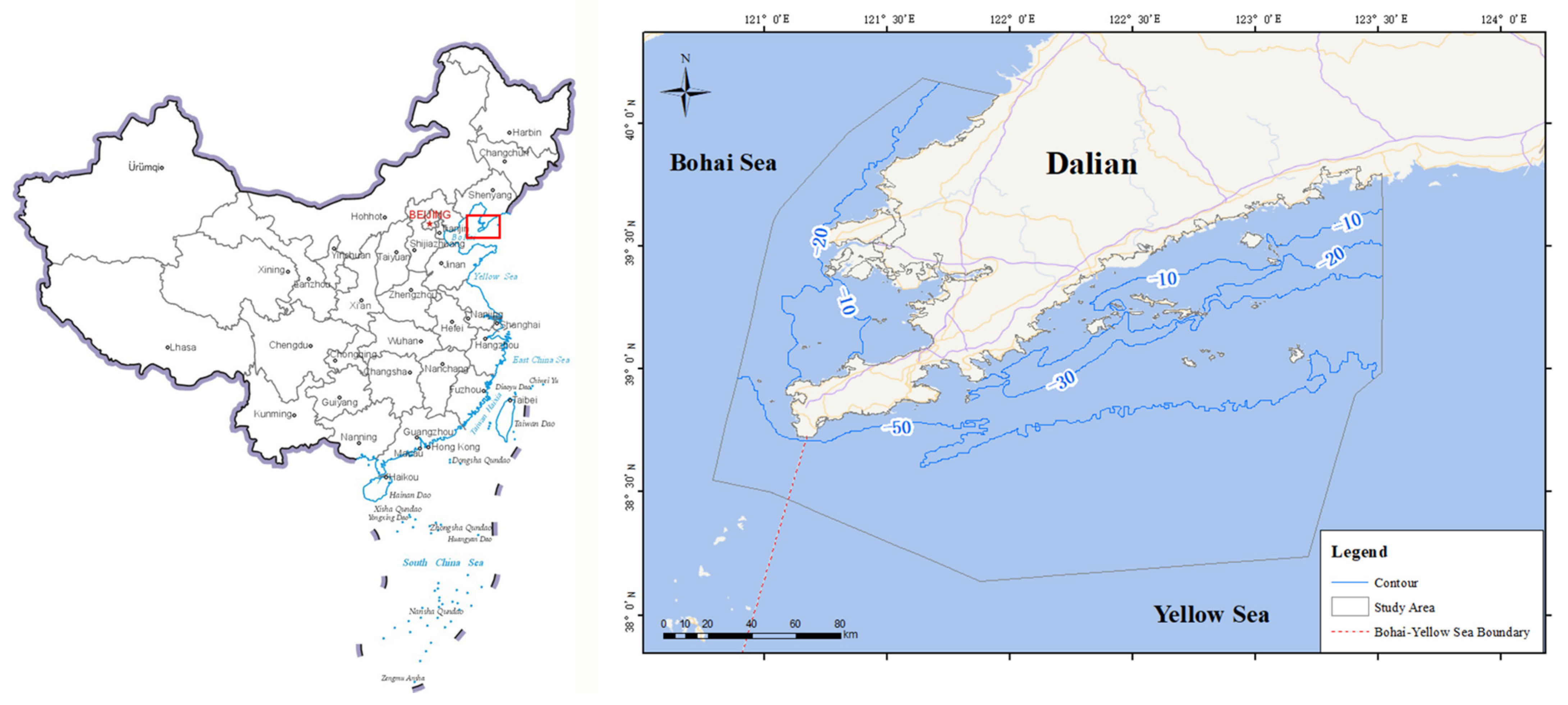
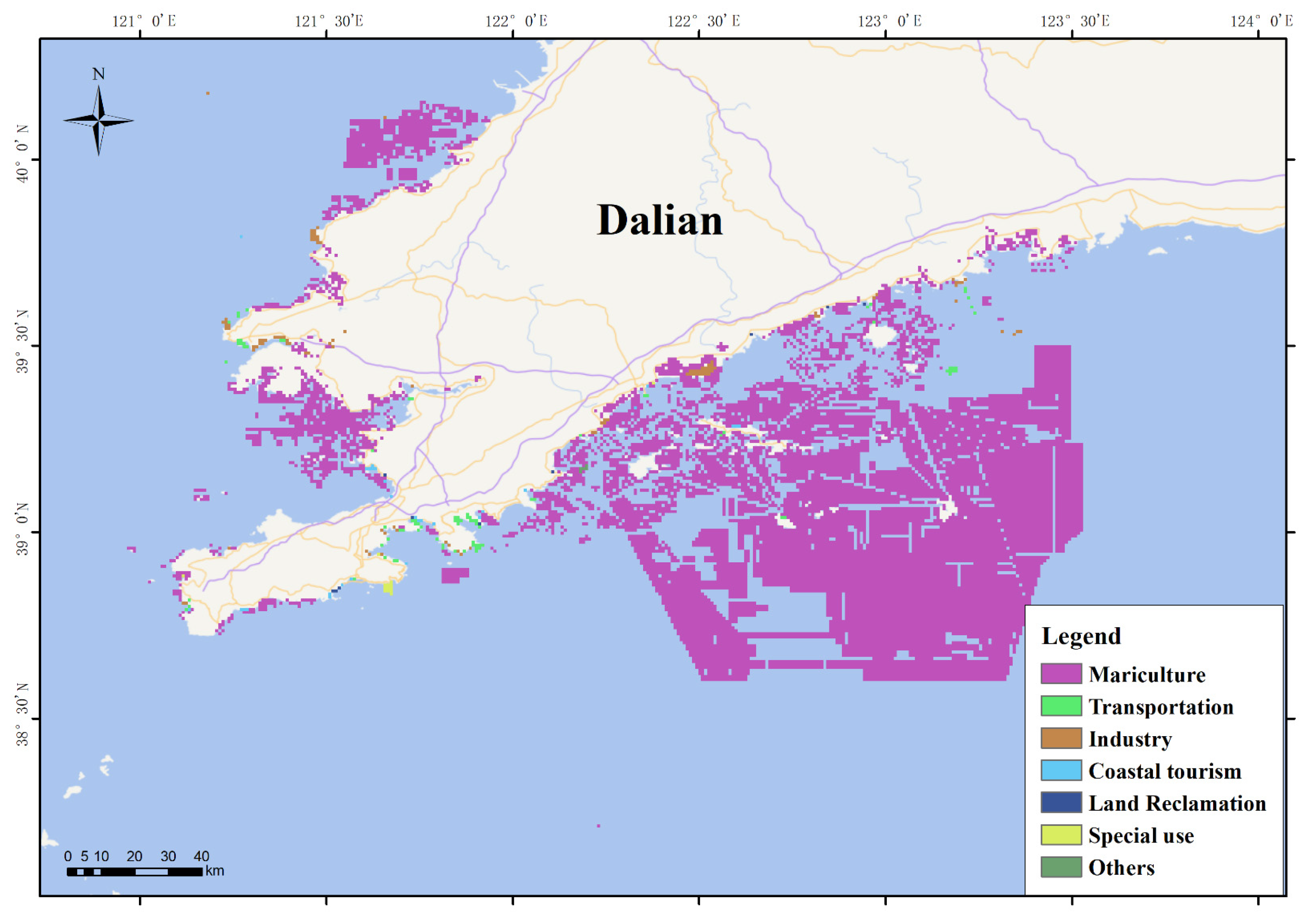

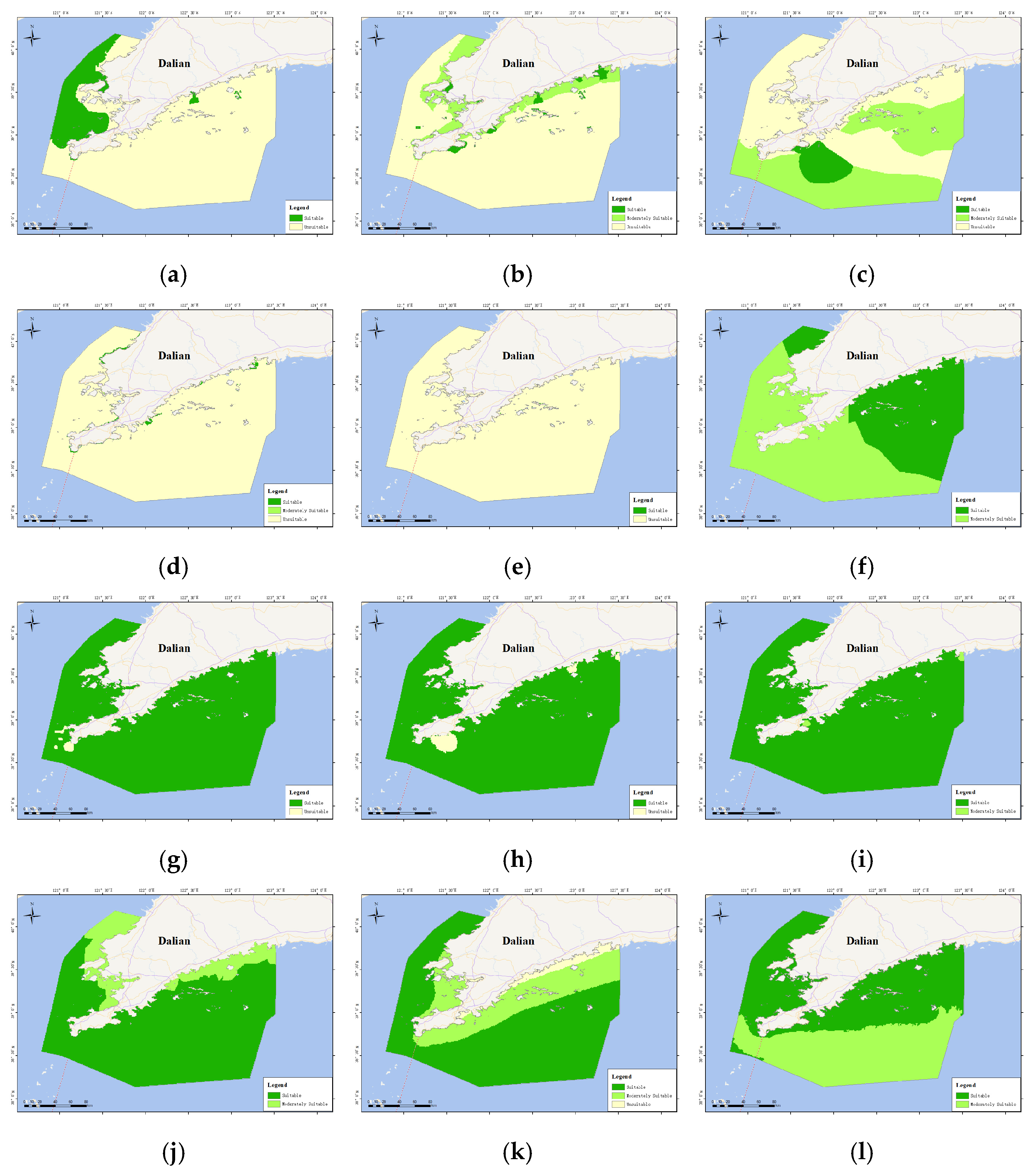
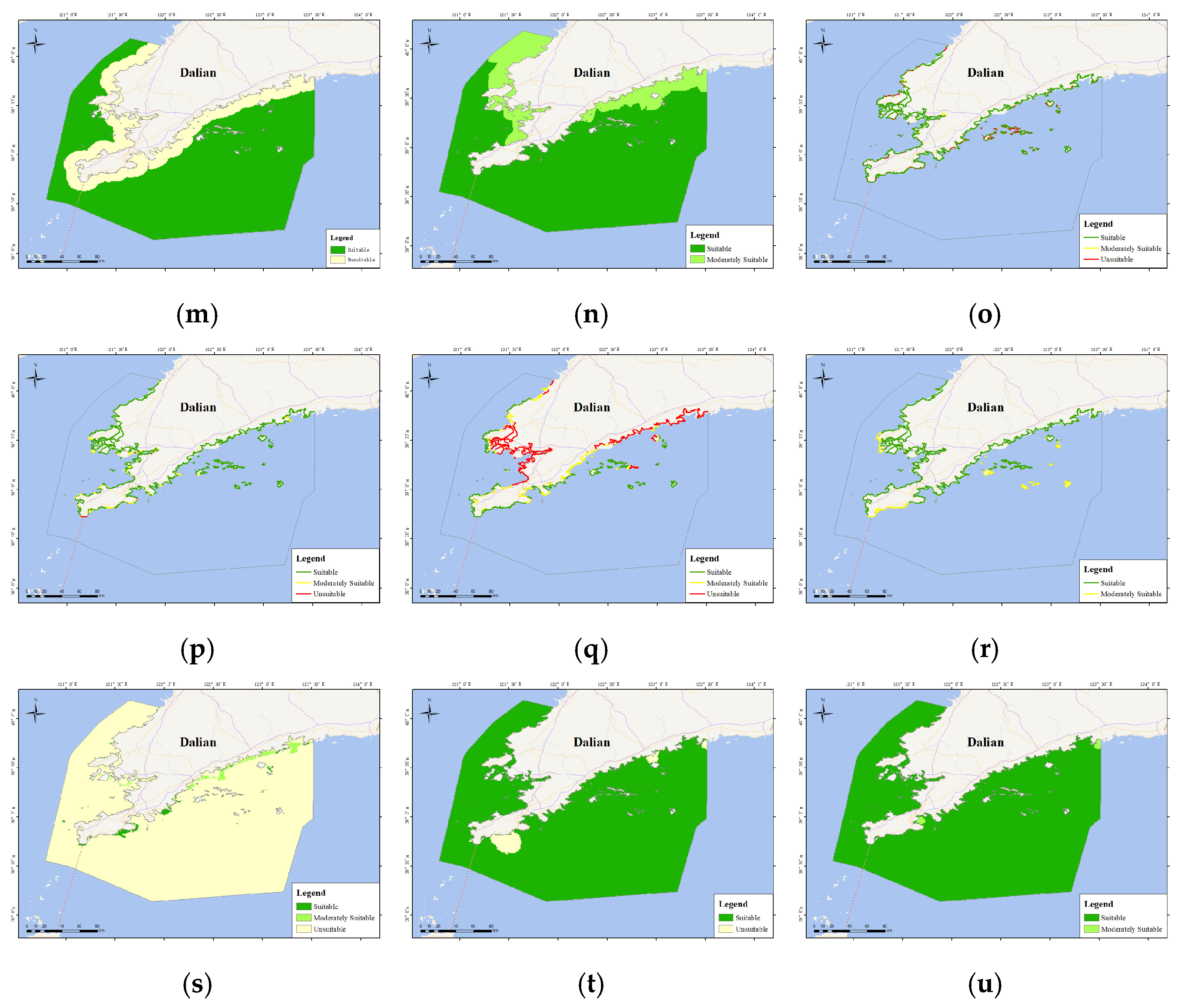
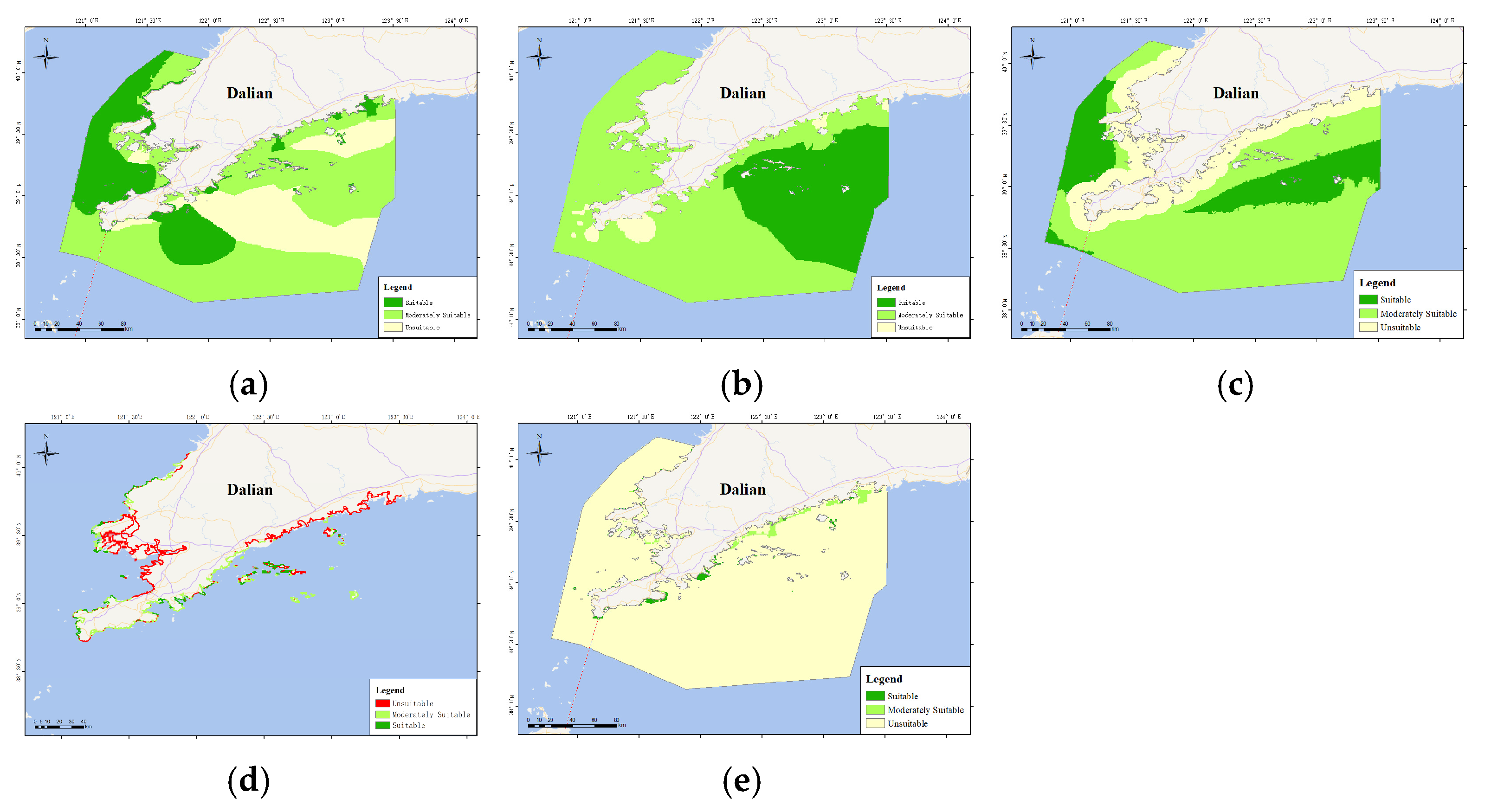
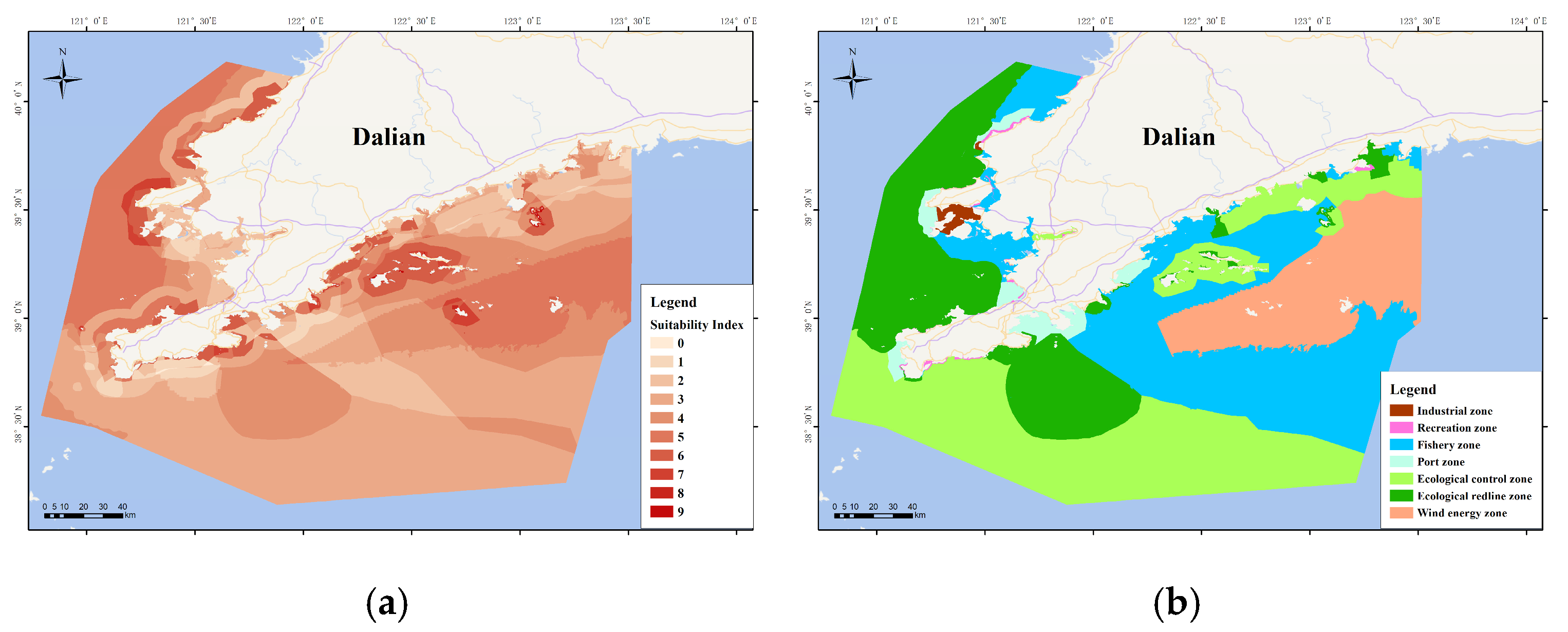

| Category | Primary Type | Secondary Type | |
|---|---|---|---|
| Marine Functional Zoning | 1. Agriculture and Fishery Zone | 1.1 Agricultural Reclamation Zone 1.2 Mariculture Zone 1.3 Proliferation Zone 1.4 Fishing Zone 1.5 Aquatic Genetic Resources Protection Zone 1.6 Fishery Infrastructure Zone | |
| 2. Port and Shipping Zone | 2.1 Port Zone 2.2 Channel Zone 2.3 Anchorage Zone | ||
| 3. Industrial and Urban Zone | 3.1 Industrial Marine Zone 3.2 Urban Development Zone | ||
| 4. Mineral and Energy Zone | 4.1 Oil and Gas Zone 4.2 Solid Mineral Zone 4.3 Salt Production Zone 4.4 Renewable Energy Zone | ||
| 5. Tourism and Entertainment Zone | 5.1 Tourist Attraction Zone 5.2 Recreation Zone | ||
| 6. Marine Protected Zone | 6.1 Marine Nature Reserve 6.2 Special Marine Protected Zone | ||
| 7. Special Use Zone | 7.1 Military Zone 7.2 Other Designated Use Zone | ||
| 8. Reserved Zone | 8.1 Reserved Zone | ||
| Territorial Spatial Planning | 1. Marine Ecological Redline Zone | — | |
| 2. Marine Ecological Control Zone | — | ||
| 3. Marine Exploitation Zone | 2.1 Fishery Zone | Fishery Infrastructure Zone Mariculture and Proliferation Zone Fishing Zone | |
| 2.2 Industrial, Mineral, and Communication Zone | Industrial Marine Zone Salt Production Zone Solid Mineral Zone Oil and Gas Zone Renewable Energy Zone Submarine Cable and Pipeline Zone | ||
| 2.3 Transportation Zone | Port Zone Shipping Zone Road, Bridge, and Channel Zone Airport Zone | ||
| 2.4 Entertainment Zone | Tourist Attraction Zone Recreation Zone | ||
| 2.5 Special Use Zone | Military Zone Scientific Research and Education Zone Marine Ecological Restoration and Shoreline Protection Engineering Zone Pollution Discharge and Dumping Zone Submarine Cultural Relics Preservation Zone | ||
| 2.6 Reserved Zone | |||
| Goal | Criteria/Indicator | Suitable (%) | Moderately Suitable (%) | Unsuitable (%) |
|---|---|---|---|---|
| Ecological protection | habitats of key protected or threatened species | 14.3 | 0.0 | 85.7 |
| habitats with high biodiversity or productivity | 2.1 | 11.4 | 86.5 | |
| critical habitats supporting key life-history stages of species | 7.1 | 45.6 | 47.3 | |
| habitats offering coastal protection service | 0.8 | 0.0 | 99.2 | |
| habitats offering carbon sequestration service | 0.0 | 0.0 | 100.0 | |
| Integrated result | 22.8 | 55.4 | 21.8 | |
| Mariculture | Phytoplankton abundance | 43.0 | 57.0 | 0.0 |
| Substrate type | 99.4 | 0.0 | 0.6 | |
| Water quality | 97.9 | 0.0 | 2.1 | |
| Red tide risk | 99.7 | 0.3 | 0.0 | |
| Sea ice risk | 85.2 | 14.8 | 0.0 | |
| Integrated result | 32.3 | 65.0 | 2.7 | |
| Wind energy farm development | Wind energy density | 70.4 | 25.7 | 3.9 |
| Water depth | 55.0 | 45.0 | 0.0 | |
| Distance to shoreline | 80.1 | 0.0 | 19.9 | |
| Sea ice risk | 85.2 | 14.8 | 0.0 | |
| Integrated result | 20.7 | 59.4 | 19.9 | |
| Port construction | Substrate type | 91.5 | 1.1 | 7.4 |
| Slope | 91.1 | 8.4 | 0.5 | |
| Water depth | 34.7 | 19.8 | 45.4 | |
| Storm surge risk | 84.4 | 15.6 | 0 | |
| Integrated result | 15.8 | 32.6 | 51.6 | |
| Coastal tourism | Tourism resources | 0.2 | 1.3 | 98.5 |
| Water quality | 97.9 | 0.0 | 2.1 | |
| Red tide risk | 99.7 | 0.3 | 0.0 | |
| Integrated result | 0.7 | 1.2 | 98.1 |
| Primary Type | Secondary Type | Area Proportion (%) |
|---|---|---|
| Marine Ecological Redline Zone | 22.0 | |
| Marine Ecological Control Zone | 32.4 | |
| Marine Exploitation Zone | Fishery Zone | 39.7 |
| Wind Energy Zone | 3.0 | |
| Port Zone | 2.6 | |
| Recreation Zone | 0.3 |
| Goal | Criteria | Indicator | Weight |
|---|---|---|---|
| Marine ecological protection | Habitats of key protected or threatened species | Habitats of Spotted Seal | 2.227 |
| Habitats of rare and endangered seabirds | 2.367 | ||
| Habitats with high biodiversity or productivity | Seagrass meadows | 2.873 | |
| Tidal flats | 2.807 | ||
| Estuaries | 2.553 | ||
| Uninhabited sea islands | 2.147 | ||
| Critical habitats supporting key life-history stages of species | Fishery spawning feedings, wintering grounds, and migration areas, aquatic germplasm resource protected areas | 3.273 | |
| Habitats offering coastal protection service | Rocky shorelines | 2.800 | |
| Sandy shorelines | 2.520 | ||
| Muddy shorelines | 2.533 | ||
| Habitats offering carbon sequestration service | Coastal saltmarshes | 2.570 | |
| seagrass meadows (already listed in “Habitats with high biodiversity or productivity”, and excluded from calculation) | — | ||
| Mariculture | Supporting resources (guiding) | Phytoplankton abundance | 0.143 |
| Substrate type | 0.857 | ||
| Environmental constraints (constraint) | Seawater quality | — | |
| Red tide risk | — | ||
| Sea ice risk | — | ||
| Port construction | Supporting resources (guiding) | Slope | 0.078 |
| Shoreline substrate type | 0.171 | ||
| Water depth | 0.750 | ||
| Environmental constraint (constraint) | Storm surge risk | — | |
| Wind energy farm development | Supporting resources (guiding) | Wind energy density | 1 |
| Environmental constrain (constraint) | Water depth | — | |
| Sea ice risk | — | ||
| Socio-economic constraint (constraint) | Distance to shoreline | — | |
| Coastal tourism | Supporting resources (guiding) | Tourism resource | 1 |
| Environmental constraint (constraint) | Seawater quality | — | |
| Red tide risk | — |
Disclaimer/Publisher’s Note: The statements, opinions and data contained in all publications are solely those of the individual author(s) and contributor(s) and not of MDPI and/or the editor(s). MDPI and/or the editor(s) disclaim responsibility for any injury to people or property resulting from any ideas, methods, instructions or products referred to in the content. |
© 2025 by the authors. Licensee MDPI, Basel, Switzerland. This article is an open access article distributed under the terms and conditions of the Creative Commons Attribution (CC BY) license (https://creativecommons.org/licenses/by/4.0/).
Share and Cite
Yang, L.; Lu, W.; Liu, J.; Liu, Z.; Borja, A.; Tao, Y.; Wang, X.; Zeng, R.; Zuo, G.; Wang, T. Multi-Objective Spatial Suitability Evaluations for Marine Spatial Planning Optimization in Dalian Coast, China. Sustainability 2025, 17, 9851. https://doi.org/10.3390/su17219851
Yang L, Lu W, Liu J, Liu Z, Borja A, Tao Y, Wang X, Zeng R, Zuo G, Wang T. Multi-Objective Spatial Suitability Evaluations for Marine Spatial Planning Optimization in Dalian Coast, China. Sustainability. 2025; 17(21):9851. https://doi.org/10.3390/su17219851
Chicago/Turabian StyleYang, Lu, Wenhai Lu, Jie Liu, Zhaoyang Liu, Angel Borja, Yijun Tao, Xiaoli Wang, Rong Zeng, Guocheng Zuo, and Tao Wang. 2025. "Multi-Objective Spatial Suitability Evaluations for Marine Spatial Planning Optimization in Dalian Coast, China" Sustainability 17, no. 21: 9851. https://doi.org/10.3390/su17219851
APA StyleYang, L., Lu, W., Liu, J., Liu, Z., Borja, A., Tao, Y., Wang, X., Zeng, R., Zuo, G., & Wang, T. (2025). Multi-Objective Spatial Suitability Evaluations for Marine Spatial Planning Optimization in Dalian Coast, China. Sustainability, 17(21), 9851. https://doi.org/10.3390/su17219851






